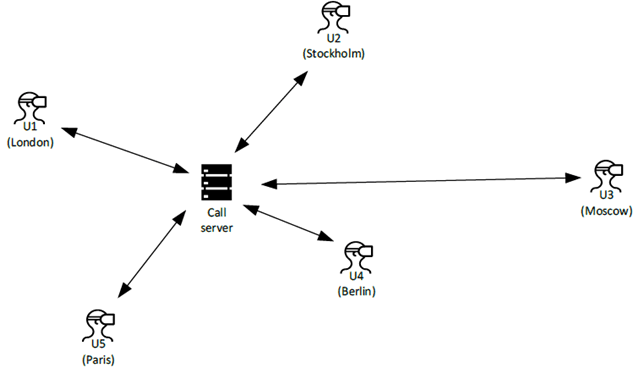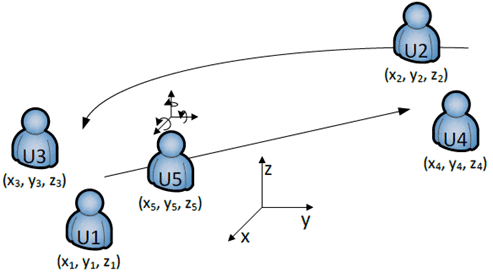Content for TR 26.928 Word version: 18.0.0
0…
4…
4.1.2…
4.2…
4.3…
4.4…
4.5…
4.6…
4.6.7
4.7…
4.9…
5…
6…
7…
8
A…
A.4…
A.7…
A.10…
A.13
A.14
A.15
A.16
A.17
A.18…
A.15 Use Case 14: 6DOF VR conferencing p. 107
| Use Case Name |
|---|
| 6DOF VR conferencing |
| Description |
|
The use case was initially described in TR 26.918 as Virtual Meeting Place:
The main idea here is to create a virtual world where people can meet and interact anonymously through their avatars with other people. A user would be able to move freely in the virtual world (6 DOF) and mingle with different groups of people depending for example on the discussion they are having. In this scenario, the user would be able to speak to other users in his/her immediate proximity and obtain a spatial rendering of what the other users in his/her immediate proximity are saying and would hear them from the same relative positions they have to him/her in the virtual world.
Below follows a more detailed description both of the physical scenario underlying the use case and the created virtual scenario.
1. Physical scenario
The physical VR conference scenario is illustrated in Figure A.15-1. Five VR conference users from different sites are virtually meeting. Each of them is using VR gear with binaural playback and video playback using an HMD. The equipment of all users supports movements in 6DOF with corresponding headtracking. The UEs of the users exchange coded audio up- and downstream with a VR conference call server. Visually, the users are represented through their respective avatars that can be rendered based on information related to relative position parameters and their rotational orientation.

2. Virtual scenario
Figure A.15-2 illustrates the virtual conferencing space generated by the conference call server. Initially, the server places the conference users Ui, i=1…5, at virtual position coordinates Ki = (xi, yi, zi). The virtual conferencing space is shared between the users. Accordingly, the audio-visual render for each user takes place in that space. For instance, from user U5's perspective, the rendering will virtually place with the other conference participants at the relative positions Ki - K5, i≠5. For example, user U5 will perceive user U2 at distance |Ki - K5| and under the direction of the vector (Ki - K5)/|Ki - K5|, whereby the directional render is done relative to the rotational orientation of U5. Also illustrated in Fig. 2 is the movement of U5 towards U4. This movement will affect the position of U5 relative to the other users, which will be taken into account while rendering. At the same time the UE of U5 sends its changing position to the conferencing server, which updates the virtual conferencing space with the new coordinates of U5. As the virtual conferencing space is shared, users U1-U4 become aware of moving user U5 and can accordingly adapt their respective renders. The simultaneous movement of user U2 works according to corresponding principles.

|
| Categorization |
|
Type:
VR
Degrees of Freedom:
6DoF
Delivery:
Interactive, Conversational
Media Components:
Audio-only, Audio-Visual
Devices:
VR gear with binaural playback and HMD video playback, Call server
|
| Preconditions |
The described scenario relies on a conference call server.
Similar scenarios can be realized without a server. In that case, the UEs of all users need to be configured to share their encoded audio and their 6DOF positional and rotational information with the UEs of all other users. Each UE will further allow simultaneous reception and decoding of audio bitstreams and 6DOF attributes from the UEs of all other users.
Specific minimum preconditions
|
| Requirements and QoS/QoE Considerations |
QoS: conversational requirements as for MTSI, using RTP for Audio and Video transport.
|
| Feasibility |
The following capabilities and technologies are required:
|
| Potential Standardization Status and Needs |
|